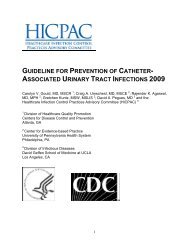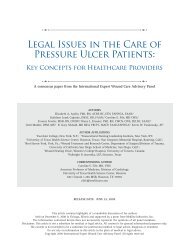SECT2.05 - Recommended Practices for Electrosurgery - Medline
SECT2.05 - Recommended Practices for Electrosurgery - Medline
SECT2.05 - Recommended Practices for Electrosurgery - Medline
- No tags were found...
Create successful ePaper yourself
Turn your PDF publications into a flip-book with our unique Google optimized e-Paper software.
RP: <strong>Electrosurgery</strong>Monopolar electrosurgery: <strong>Electrosurgery</strong> inwhich only the active electrode is in the surgicalwound, and the electrical current is directed throughthe patient’s body, received by the dispersive pad,and transferred back to the generator, completing themonopolar circuit.Oxygen-enriched environment: Atmospherecontaining more than 21% oxygen, frequentlyoccurring in the oropharynx, trachea, lower respiratorytract, and near the head and neck duringadministration of oxygen to the patient.Return electrode continuity monitor: A safetyfeature of a single foil dispersive electrode thatdetects an unconnected dispersive electrode or abreak in the return electrode cord.Return-electrode contact quality monitoring: Adynamic monitoring circuit measuring impedanceof the dispersive return electrode. If the dispersiveelectrode becomes compromised, the circuit inhibitsthe ESU’s output.Ultra low particulate air (ULPA): Theoretically, aULPA filter can remove from the air 99.9999% ofbacteria, dust, pollen, mold, and particles with asize of 120 nanometers or larger.Ultrasonic scalpel: A cutting/coagulation devicethat converts electrical energy into mechanicalenergy, providing a rapid ultrasonic motion.Vessel sealing device: Bipolar technology thatfuses collagen and elastin in the vessel walls andpermanently obliterates the lumen of the vessel.References1. Association <strong>for</strong> the Advancement of MedicalInstrumentation. ANSI/AAMI HF18:2001. ElectrosurgicalDevices. Arlington, VA: Association <strong>for</strong> the Advancementof Medical Instrumentation; 2001.2. ECRI. <strong>Electrosurgery</strong>. Healthcare Risk Control RiskAnalysis. 2007;4(Surgery and Anesthesia 16).3. Electrosurgical units. Health Devices. 1998;27(3):93-111.4. Odell RC. Pearls, pitfalls, and advancements in thedelivery of electrosurgical energy during laparoscopy.Problems in General Surgery. 2002;19(2):5-17.5. Jones CM, Pierre KB, Nicoud IB, Stain SC, MelvinWV 3rd. <strong>Electrosurgery</strong>. Curr Surg. 2006;63(6):458-463.6. ECRI. Laparoscopic electrosurgery risks. OperatingRoom Risk Management. 1999;2(Surgery 19):1-11.7. Guidance section: ensuring monopolar electrosurgicalsafety during laparoscopy. Health Devices.1995;24(1):20-26.8. Wu MP, Ou CS, Chen SL, Yen EYT, Rowbotham R.Complications and recommended practices <strong>for</strong> electrosurgeryin laparoscopy. Am J Surg. 2000/1;179(1):67-73.9. Vilos GA, Newton DW, Odell RC, Abu-Rafea B,Vilos AG. Characterization and mitigation of stray radiofrequencycurrents during monopolar resectoscopic electrosurgery.J Minim Invasive Gynecol. 2006;13(2):134-140.10. Physician Insurers Association of America. LaparoscopicInjury Study. Rockville, Md: Physician InsurersAssociation of America; 2000:1-5.11. ECRI. Safety technologies <strong>for</strong> laparoscopicmonopolar electrosurgery; devices <strong>for</strong> managing burnrisks. Health Devices. 2005;34(8):259-272.12. Evaluation of Electroscope Electroshield System.Health Devices. 1995;24(1):11-19.13. Dennis V. Implementing active electrode monitoring:a perioperative call. Ssm. 2001;7(2):32, 34-38.14. Harrell GJ, Kopps DR. Minimizing patient risk duringlaparoscopic electrosurgery. AORN J. 1998;67(6):1194-1196.15. <strong>Electrosurgery</strong> safety issues. PA-PSRS Patient SafetyAdvisory. 2006;3(1):1-3.16. ECRI. The patient is on fire! A surgical fires primer.http://www.mdsr.ecri.org/summary/detail.aspx?doc_id=8197. Accessed November 4, 2009.17. Burns and fires from electrosurgical active electrodes.Health Devices. 1993;22(8-9):421-422.18. Electrosurgical safety: conducting a safety audit.Health Devices. 2005;34(12):414-420.19. Annex D. The safe use of high-frequency electricityin health care facilities. In: Health Care Facilities Handbook.10th ed. Quincy, MA: National Fire Protection Association;2005.20. ECRI Institute. <strong>Electrosurgery</strong> checklist. OperatingRoom Risk Management. 2007;2(Surgery 10).21. De Marco M, Maggi S. Evaluation of stray radiofrequencyradiation emitted by electrosurgical devices. PhysMed Biol. 2006;51(14):3347-3358.22. Massarweh NN, Cosgriff N, Slakey DP. <strong>Electrosurgery</strong>:history, principles, and current and future uses. J AmColl Surg. 2006;202(3):520-530.23. ESU burns from poor dispersive electrode sitepreparation. Health Devices. 1993;22(8-9):422-423.24. Skin burns resulting from the use of electrolytic distention/irrigationmedia during electrosurgery with a rollerablationelectrode. Health Devices. 1998;27(6):233-235.25. AORN guidance statement: Care of the perioperativepatient with an implanted electronic device. In: PerioperativeStandards and <strong>Recommended</strong> <strong>Practices</strong>. Denver,CO: AORN, Inc; 2009:207-228.26. Food and Drug Administration. Medical devicereporting: Manufacturer reporting, importer reporting, userfacility reporting, distributor reporting. Fed Regist.2000;65:4112-4121.27. Misconnection of bipolar electrosurgical electrodes.Health Devices. 1995;24(1):34-35.28. ECRI Institute. Surgical fire safety. Health Devices.2006;35(2):45-46.29. Center <strong>for</strong> Devices and Radiological Health.Manufacturer and User Facility Device Experience(MAUDE) Database Adverse Event Report 421908.Reported October 9, 2002. http://www.accessdata.fda.gov/scripts/cdrh/cfdocs/cfMAUDE/Detail.CFM?MDRFOI__ID=421908. Accessed November 4, 2009.30. Fire caused by improper disposal of electrocauteryunits. Health Devices. 1994;23(3):98.31. Alternate-site burns from improperly seated electrosurgicalpencil active electrodes. Health Devices.2000;29(1):24-27.2012 Perioperative Standards and <strong>Recommended</strong> <strong>Practices</strong> Equipment and Product Safety 115
















